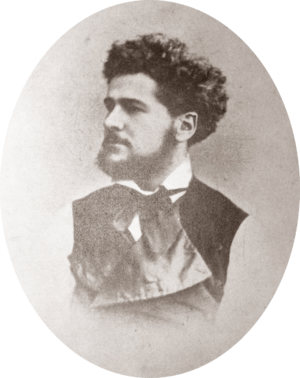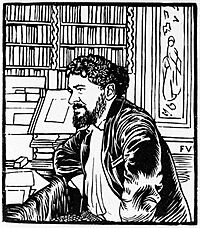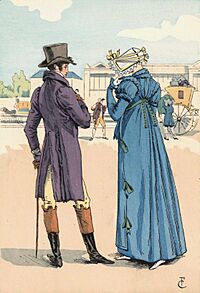Octave Uzanne facts for kids
Quick facts for kids
Octave Uzanne
|
|
|---|---|

Photography by Nadar (c. 1890)
|
|
| Born | Louis Octave Uzanne 14 September 1851 Auxerre, France |
| Died | 31 October 1931 (aged 80) Saint-Cloud, France |
| Occupation | Writer, journalist, publisher |
| Nationality | French |
| Period | 19th century |
| Signature | |
Octave Uzanne (born September 14, 1851 – died October 31, 1931) was a French writer, publisher, and journalist from the 1800s. He was also a bibliophile, which means he loved collecting books.
Uzanne was known for studying writers from the 1700s. He helped publish many works that had not been seen before. These included writings by authors like Paradis Moncrif and Baudelaire. He also started a group called the Société des Bibliophiles Contemporains (Society of Contemporary Book Lovers), where he was the president.
His studies led to many books and articles. He often wrote for famous newspapers like L'Echo, Le Plume, and Le Figaro. One of his favorite topics was fashion and women's roles in France around the late 1800s. He wrote books like Son Altesse la femme (Her Highness Woman) and La Française du siècle (The Frenchwoman of the Century). He also wrote his own novels and fantasy books.
Contents
Discovering Octave Uzanne's Life Story
Early Years and Education
Louis Octave Uzanne was born on September 14, 1851, in Auxerre, France. His family was well-off and came from Savoy. His father, Charles-Auguste Omer Uzanne, was a merchant.
Octave first studied in his hometown. After his father passed away, he moved to Paris. There, he attended the Collège Rollin, a special school for children from wealthy families. In Paris, he became very interested in how books and old writings changed over time.
During the Franco-Prussian War (1870–1871), he spent some time at a school in Richmond, England. He later studied law, but he stopped in 1872. This was because he received an inheritance, which allowed him to follow his passion for writing and books.
Becoming a Book Lover and Writer
Uzanne often visited the Bibliothèque de l'Arsenal (Library of the Arsenal). Here, he met other people who loved books, like the journalist Charles Monselet. He also joined the Société des Amis des Livres (Society of Friends of Books), which was the first French group for book lovers since 1820.
At the start of his career, Uzanne focused on writers from the 1700s who were not very well known. He published many volumes of their work. He admired the Goncourt brothers, who also wrote about 18th-century France. Uzanne looked for mentors who loved books as much as he did.
Even though he studied old subjects, he was very up-to-date on new printing methods. His 1879 book, Le bric-à-brac de l'amour (A Collection of Love), was one of the first to use new printing techniques. These included zincography and photo-mechanical reproduction. Uzanne believed there were two types of book collectors. Some saw books as investments, like stocks. Others, whom he called "pure," loved books for their content, rarity, or beauty.
Leading Book Societies and Magazines
Uzanne left the Société des Amis des Livres because he felt it was too old-fashioned. He then started two new book-loving societies. These were the Société des Bibliophiles Contemporaines (1889–1894) and the Societé des Bibliophiles Indépendants (1896–1901). The first group had 160 members, including writers and artists.
Uzanne also edited several magazines for book lovers. These included Le livre : bibliographie moderne (The Book: Modern Bibliography) and L'Art et l'Idée (Art and Ideas). In the early 1890s, he was seen as a top expert for people who loved books. However, some of his books received mixed reviews, especially for their illustrations.
Unlike many book collectors of his time, Uzanne was interested in creating new, beautiful books. He worked closely with printers, artists, and bookbinders. Many famous artists, like James McNeill Whistler and Félicien Rops, worked with him. Rops even called Uzanne "the Bibliophile's dream."
The New York Times praised Uzanne's 1894 book, La Femme à Paris (Woman in Paris). They said it was a "highly-artistic achievement" and that its style made it pure literature. Uzanne's books often explored the lives of women in French society. He also believed that women's figures and decorations were important in French art.
Uzanne's work with books happened when printing methods were changing. Manual printing was being replaced by photo-mechanical methods. In 1894, his collection of modern books was sold. It included some of the best examples of French bookbinding from the late 1800s.
Journalism and New Technologies

As a journalist, Uzanne sometimes used the pen name "la Cagoule." He wrote for newspapers like L'Écho de Paris and Le Gaulois. He also wrote for foreign magazines such as The Studio and Scribner's Magazine.
In 1894, he wrote an article called "The End of Books." In it, he predicted that books might be replaced by new technologies like the phonograph. He even imagined the rise of radio and television. Uzanne was very interested in modern technology and how it could spread words, sounds, and images.
This interest was clear in his book publishing and in an article he wrote for Le Figaro in 1893. He described visiting US President Grover Cleveland and inventor Thomas Edison at the Chicago World's Fair. There, he saw the Kinetoscope, an early movie viewer, before it was shown to the public.
Uzanne's writing style often included English words and new, unusual words he created.
Writing About Fashion
Another big interest for Uzanne was women's fashion. He wrote many books and articles on this topic, which were later translated into English. He especially focused on the "Parisienne," the women of Paris.
Some people believe Uzanne wanted to bring back French national pride. He felt strongly about his country, especially after France's defeat by Prussia in 1870. This feeling showed in his efforts to promote new decorative arts.
His first and most famous book on fashion was L'Éventail (The Fan), published in 1882. It was a charming, illustrated story about hand fans. He said it was not a deep academic work, but the first in a series of "little books for the boudoir" (a woman's private sitting room).
"Among the jewels of female ornamentation, the fan is the priority because, in the land of grace and spirit, still shines in the front row."
— (Octave Uzanne, L'Éventail, 1882, p. 6)
His second fashion book, L'ombrelle – le gant – le manchon (The Sunshade, Muff, and Glove), came out in 1883. It was also illustrated by Paul Avril. In this book, Uzanne highlighted the muff, saying, "Its name alone has something adorable, downy, and voluptuous about it."
Later, he combined these texts into Les ornements de la femme (The Ornaments of Woman, 1892). His 1898 work, Les Modes de Paris (Fashions in Paris), was called "the most complete and exhaustive work on the subject of French fashions" by The New York Times. In this book, he wanted to bring back the elegant, feminine style of an earlier period. He also criticized the plain clothing of the "new woman" of his time.
Uzanne also wrote historical novels like La Française du siècle (The Frenchwoman of the Century, 1886). In this book, he suggested that the French Revolution had a "lamentable and disastrous" effect on women. He believed it took away French spirit and grace. The story covered the evolution of society and women from the French Revolution up to the 1880s. He later republished similar books with different titles.
Later Life and Passing
Octave Uzanne never married. He explored the idea of women artists, but he believed that creative ability belonged only to men.
Uzanne was seen as a classic figure of the Belle Époque, a beautiful time in French history. He was described as a "handsome monsieur with a beard" and an "elegant storyteller." He had a mix of old-fashioned tastes, loving forgotten authors, but he was also a very new and creative artist and book lover. He was different from the old-school book collectors.
Uzanne spent his final years in his apartment in Saint-Cloud, France. He passed away on October 21, 1931. His body was cremated at the Père Lachaise Cemetery.
See also
 In Spanish: Octave Uzanne para niños
In Spanish: Octave Uzanne para niños





